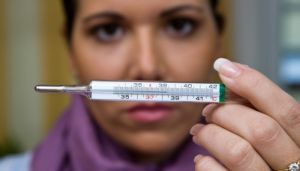 All tissues and organs in the human body retain their normal structure and perform their functions thanks to trophic( constant cellular nutrition), carried out by the vegetative department by the nervous system directly or through special substances - mediators.
All tissues and organs in the human body retain their normal structure and perform their functions thanks to trophic( constant cellular nutrition), carried out by the vegetative department by the nervous system directly or through special substances - mediators.
Trophic is directly dependent on the work of the heart and the vascular tone. Disorders of normal cell nutrition( trophic disorders) can have a neurogenic origin.
This does not completely lose the function of the organ, but its adaptation to the changing conditions of the environment and the needs of the organism suffers. Of the large number of disorders of trophism, the most common are angiotrophoneuroses. What is this disease and how to cope with it?
The essence and varieties of the pathology of
The term "angiotrophoneurosis" is used to refer to a group of diseases that arise on the soil of disturbed vasomotor and trophic innervation of organs and tissues.
These diseases are called vascular-trophic neuropathies or vegetative-vascular neurosis, because they are manifested by the paradoxical reaction of capillaries to changes in the external environment or internal state of the body, as well as by dystrophic and functional disorders.
The group of angiotroponeuroses includes such pathological conditions:
- hemiatrophy - decrease in the volume of the trunk, extremities or face on one side in combination with trophic disorders in tissues;
- hemihydrotrophy - the opposite state( increase in size);
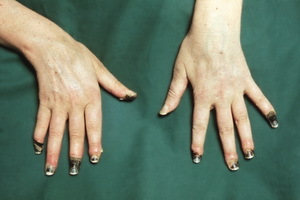
- Reynaud's disease is a classic example of the spastic form of angiotrophoneurosis, manifested by attacks of constriction of the vessels in the form of symmetric painful blanching or blueing of the fingers, as well as the tip of the nose, ears, lips against a background of hypothermia or stress;
- Raynaud's syndrome is a manifestation of such serious diseases as systemic scleroderma, syringomyelia, osteochondrosis of the spine;
- erythromelalgia is a form of the disease characterized by paroxysmal enlargement of small vessels in the form of redness and pain in the fingers;
- edematous forms associated with sudden dilatation of vessels - urticaria, Quincke's edema, as well as trophodemia of Meij( limited edema of large sizes on the legs);
- occupational diseases - vibration disease, "miner's foot", cold reaction;
- angiotrophoneurosis of internal organs ( disorders of gastric secretion, vasomotor rhinitis and others), of the brain ( migraine, Ménière's disease).
Causes and mechanism of development of the
disorder An important role in the origin of the examined disease is played by a hereditary predisposition to vasomotor and trophic disorders, as well as constitutional features of the organism, in particular, the inferiority of the vascular reaction due to impaired innervation.
The provoking factors for the formation of angiotrophoneurosis are:
- infections;
- poisoning with salts of heavy metals( mercury, lead);
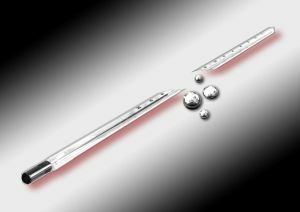
- prolonged hypothermia;
- chronic intoxication( alcohol, nicotine);
- endocrine disorders( puberty in adolescents);
- allergic reactions;
- metabolic disorders;
- permanent muscular overstrain, vibration, prolonged forced posture with bent legs;
- cervical osteochondrosis;
- traumatic injuries of upper limb vessels;
- injury to the central nervous system or peripheral nerve trunks.
A malfunction in the system of vasomotor and trophic innervation can occur at any level( cortex, stem part of the brain, hypothalamus, spinal cord or peripheral nerve fibers).The definition of the localization of violations is of practical importance for the choice of tactics for treating a patient.
The mechanism of angiotrophoneurosis development is so complicated that it requires the involvement of specialists from different directions.
Clinical manifestations of
The disease is characterized by a variety of symptoms depending on the shape of the angiotrophoneurosis. Some patients have mainly vasomotor disorders - vasospasm with cooling and blanching of limbs and( or) widening of capillaries with hyperemia and painful sensations.
Another category of patients suffers more trophic disorders( edema, necrosis, ulcers).Many people have both types - disorders of microcirculation and dystrophic phenomena. Vasomotor-trophic neurosis can affect the skin, subcutaneous fat layer, internal organs, hands, feet, face and trunk.
Reynaud disease manifestation
The most frequent form of angiotrophoneurosis is the spastic form, in classic form is Raynaud's disease. In this disease, against a background of stress or hypothermia, there is a spasm of the blood vessels of the hands, accompanied by pain, cold, numbness, and pallor of the fingers.
Then there is cyanosis( cyanosis), the pain grows, acquires a burning character. In the next stage, the pain subsides, the pallor gives way to reddening( hyperemia).The whole attack lasts several minutes and is repeated with different frequency in different patients, the more often this happens, the faster the trophic disorders( cracks, wounds, scabs on the skin) join.
Sometimes changes also affect the tips of the ear, nose, lips, tongue. Raynaud's disease is symmetric in nature, unlike Raynaud's syndrome, which occurs in scleroderma and other severe ailments.
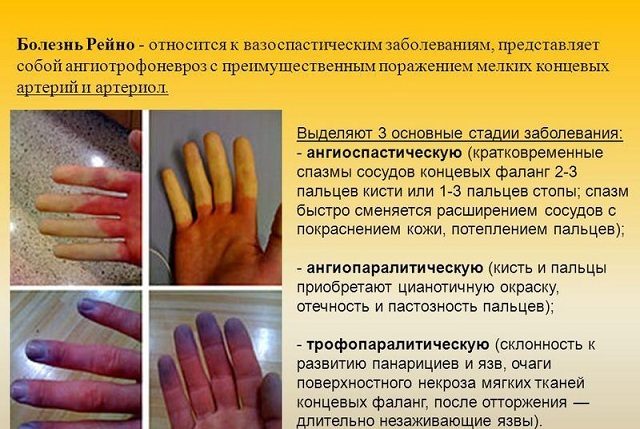
Methods of treatment
Before starting treatment, the patient is examined by a specialist - a vascular surgeon with the possible involvement of other doctors.
Treatment of different types of angiotrophoneurosis depends on the cause and mechanism of the appearance of the disease.
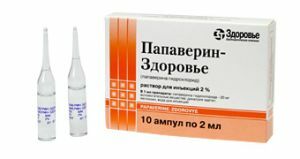 Spastic forms of the disease usually require the appointment of antispasmodics( Papaverin, Platyphylline), ganglion blockers( Pentamine, Pachycarpine), as well as vitamins( Cyanocobalamin).
Spastic forms of the disease usually require the appointment of antispasmodics( Papaverin, Platyphylline), ganglion blockers( Pentamine, Pachycarpine), as well as vitamins( Cyanocobalamin).
Individual methods of physiotherapy are chosen: galvanic collars, baths with hydrogen sulphide and radon, electrosleep and hypnosis, mud procedures. Sometimes novocain blockades of sympathetic nodes are used, in particularly severe cases, radiotherapy is possible, as well as radical surgical operations( sympathectomy).
Forms of angiotrophoneurosis with the expansion of the vessels of the extremities are treated with the use of vasoconstrictors containing caffeine, epinephrine or ephedrine, as well as with calcium, ascorbic acid, pyridoxine.
If the disease develops against the background of concomitant pathology, then the main disease is treated with glucocorticosteroids, antibiotics and other means. The probability of a favorable outcome will depend on the severity of the underlying disease and the effectiveness of the treatment.
Regarding the independent forms of angiotrophoneurosis, the prognosis is determined depending on the type of pathology in a particular patient. For example, with Raynaud's disease, changes can be persistent until the gangrene of the fingers, with acrocyanosis and vibration disease, the prognosis is usually favorable.
Preventative measures
Prophylaxis is to eliminate the causes that caused the disease. It is impossible to fight with heredity. However, adherence to certain rules of behavior with angiotrophoneurosis will help to overcome unpleasant symptoms of the disease and prevent the progression of pathology.
So, what are these rules:
- consult a doctor at the first sign of the disease;
- conscientiously implement all medical recommendations and therapy courses;
- completely eliminate nicotine and alcohol;
- do not allow hypothermia, dress in the weather, always wear warm shoes, mittens or knitted gloves in the cold season;
- to avoid psychotraumatic situations at work and at home;
- to abandon heavy physical work, especially in the cold;
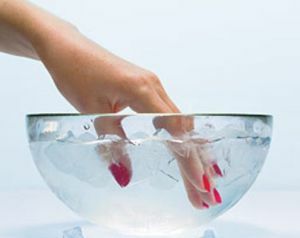
- eliminate overwork, lack of sleep;
- adhere to proper nutrition with a high content of fruits and vegetables;
- to train blood vessels - contrasting baths for hands, exercise and sports;
- to take care of the skin of hands with nutritious creams, avoiding dryness and cracking of the skin;
- in a timely manner to treat all associated diseases( allergic, endocrine, neurologic and others).
With all medical recommendations and proper treatment with angiotrophoneurosis you can cope.


